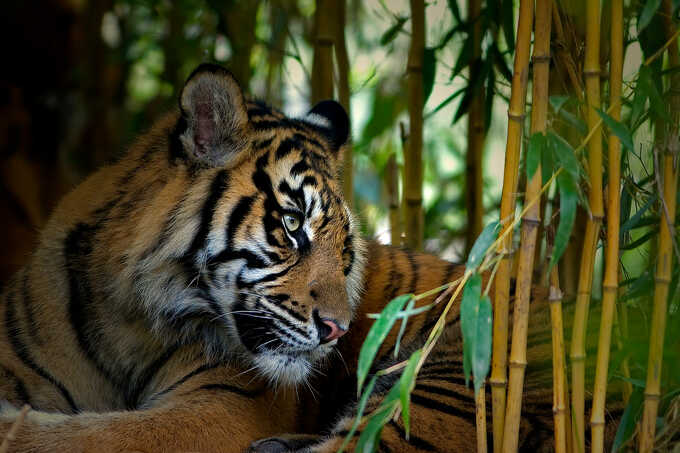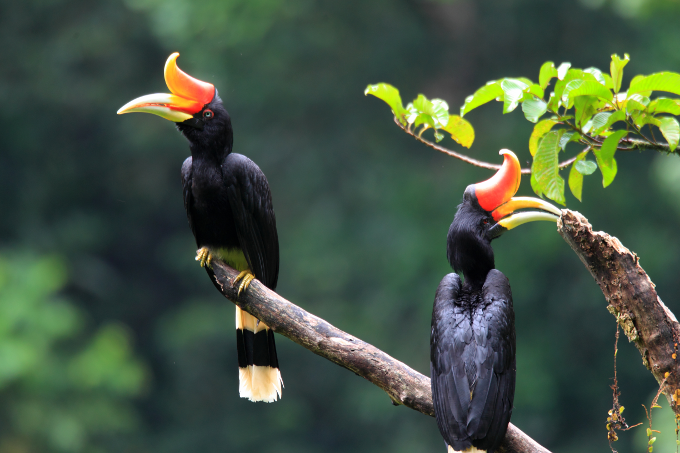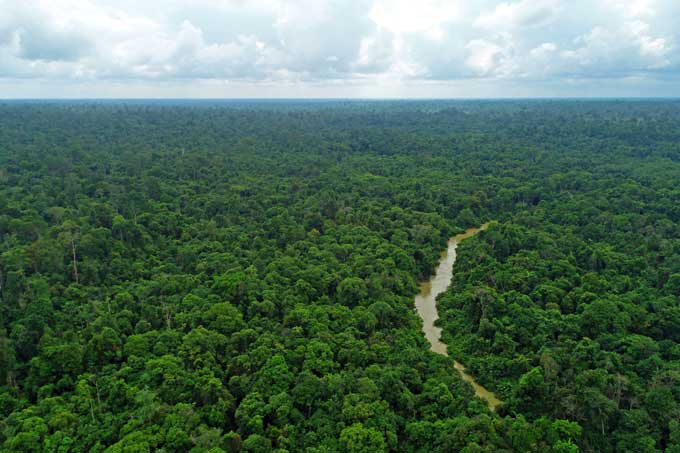Seeking signs in the rainforest
Protecting endangered Sumatran tigers, hornbills and more: Monitoring work in Indonesia up close

Sumatran tiger in the rainforest - photo: Thomas Herzog
Leaf litter rustles under our rubber boots; overhead the birds, insects and gibbons deliver their best morning concert. It’s six in the morning, and we are on the move in the rainforest of Hutan Harapan, located on the Indonesian island of Sumatra. My colleague Hyeun-Ji Lee and I normally support this forest conservation project from afar, out of the NABU Federal Headquarters in Berlin. But today, we are on the ground, experiencing the project’s species research and rainforest conservation in action.
Researchers have a keen ear for discoveries
Along with patience and knowledge of species, those hoping to conduct research in the Indonesian rainforest will need one important thing: good hearing. Chirps and rustlings sound everywhere throughout the canopy of leaves, and one only seldomly catches sight of their source. Fadlurrahman, or Aman for short, is part of the research team in Hutan Harapan and knows this all too well. “90 percent hearing, ten percent seeing”, he explains, as we sneak through the woods. He and his team study the biodiversity of the area, in order to draw conclusions about the health of the forest – and about its development over the course of time.
“That was a hornbill. And that was a bulbul”, Aman calls to us. The biologist recognises most birds of the region by their song. “When we identify bird species, we enter them for this GPS location with the tablet. We regularly pass through the forest, record bird calls for later analysis and collect data on where which species are located.”
The abundance of species in the forest is often only apparent at a second glance. Aman leads us to a tree trunk covered in scratches. “These trees are sun bears’ favorite for climbing, because bee colonies often live in their crowns.” As we leave the forest and walk a ways on the bordering, dusty red road, our eyes widen. Aman gestures at a series of round prints: “An elephant was here last night.”
Species and habitats under pressure from all sides
The threats facing the rainforest also leave their traces. On our way back, we pause at a burned-out area. Just yesterday, Aman and his colleagues extinguished a forest fire here. “This fire was most likely started by poachers who wanted easier access to the forest”, he tells us, and points at a trampled path through the undergrowth. “From here, they probably pressed on into the forest.” This, too, is part of his work: Identifying and extinguishing forest fires as soon as possible, and stopping poaching. Both tasks are not without danger.
That’s why the research team takes particular care with their data. “We have to be extremely cautious when publishing our findings”, says Aman. “Information on where rare species are located in the forest must not pass into the wrong hands.” Especially endangered species like hornbills and Sumatran tigers could otherwise end up a target of poachers.
During lunch, we can hear the work operations on the palm oil plantations – a further threat to the forest. Like a green island, the protected area lies amidst an ocean of monocultures, where once biodiverse rainforests grew. Sumatra has already lost 98 percent of its lowland rainforests to deforestation, driven by global demand for resources like palm oil, wood fiber and coal – including demand from Germany.
More knowledge for more conservation
In camp that afternoon, we pore over maps of the forest. The project area is almost 100,000 hectares in size. “The deep jungle at the heart is much denser and more difficult to reach than the forested areas on the edges”, says Hyeun-Ji. Within the project, she is responsible for NABU’s biodiversity monitoring. Since 2007, NABU has been working to support the protection of Hutan Harapan, in order to save one of Sumatra’s last remaining lowland rainforests from deforestation.
The difficult access to the inner regions of the forest is a blessing for its animals and plants, making them safer from external impacts like poaching and illegal felling of trees. But at the same time, it also makes researchers’ work harder. Camera traps are one helpful solution. These allow researchers to observe the species without being on the ground themselves. “Setting up a camera trap requires the team to be on the go for a whole day. But it’s worth the effort”, says Hyeun-Ji. “For example, that’s how we were able to document tapir offspring in the forest.”
As we while away the evening by a lake at the edge of the forest, I ask Hyeun-Ji why species research is so important for the conservation of Hutan Harapan. “Only knowledge can make nature conservation possible”, the biologist replies. “Data on presence, population density and distribution help us evaluate the effectiveness of conservation measures like the reduction of human-wildlife conflicts.” As darkness falls, we slip back into our rubber boots. This time, it’s a chorus of frogs who provide a little night music, leading us back into the forest.
Anna Wenzel (reprinted and translated from Naturschutz heute 4/24)
Want to help us protect the last rainforests and Sumatran tigers?
Donate now for the Forest of Hope!
Payment reference: Hutan Harapan
IBAN: DE65 3702 0500 0008 0518 05
Bank für Sozialwirtschaft
For questions:
Tel. +49 030.28 49 84-15 60
Email: Spenden@NABU.de
MORE INFORMATION
Hutan Harapan, the "forest of hope", is a tropical lowland forest in Sumatra, Indonesia, and one of our most precious conservation and restoration programmes. The forest is one of the last refuges for endangered species and provides countless ecosystem services. more →
After years of fruitless negotiations, our fears are realised: The construction of a road for coal transport through the Indonesian rainforest of Hutan Harapan will fragment one of the last refuges for species like Sumatran tigers, sun bears and hornbills. more →





